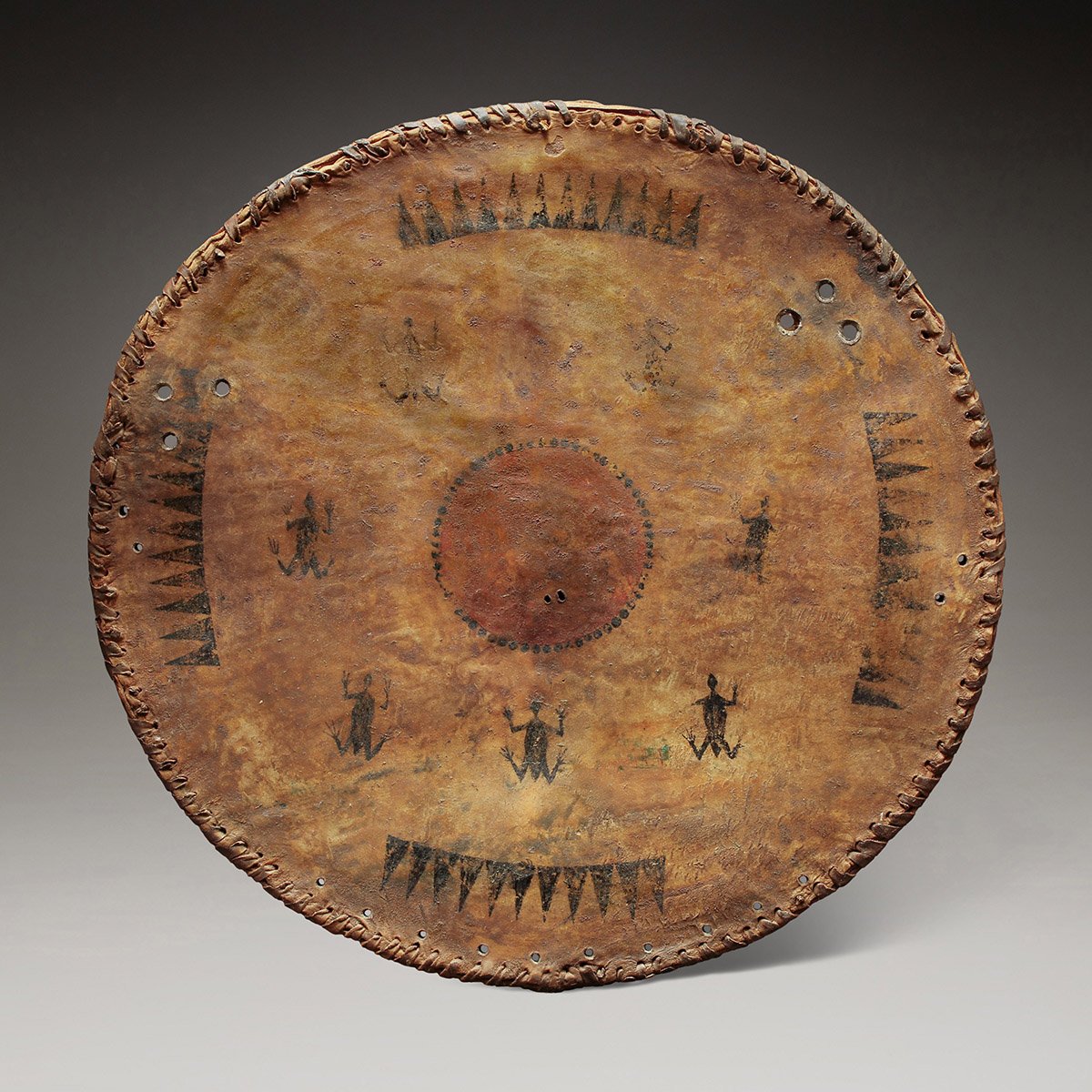 Image 1 of 8
Image 1 of 8

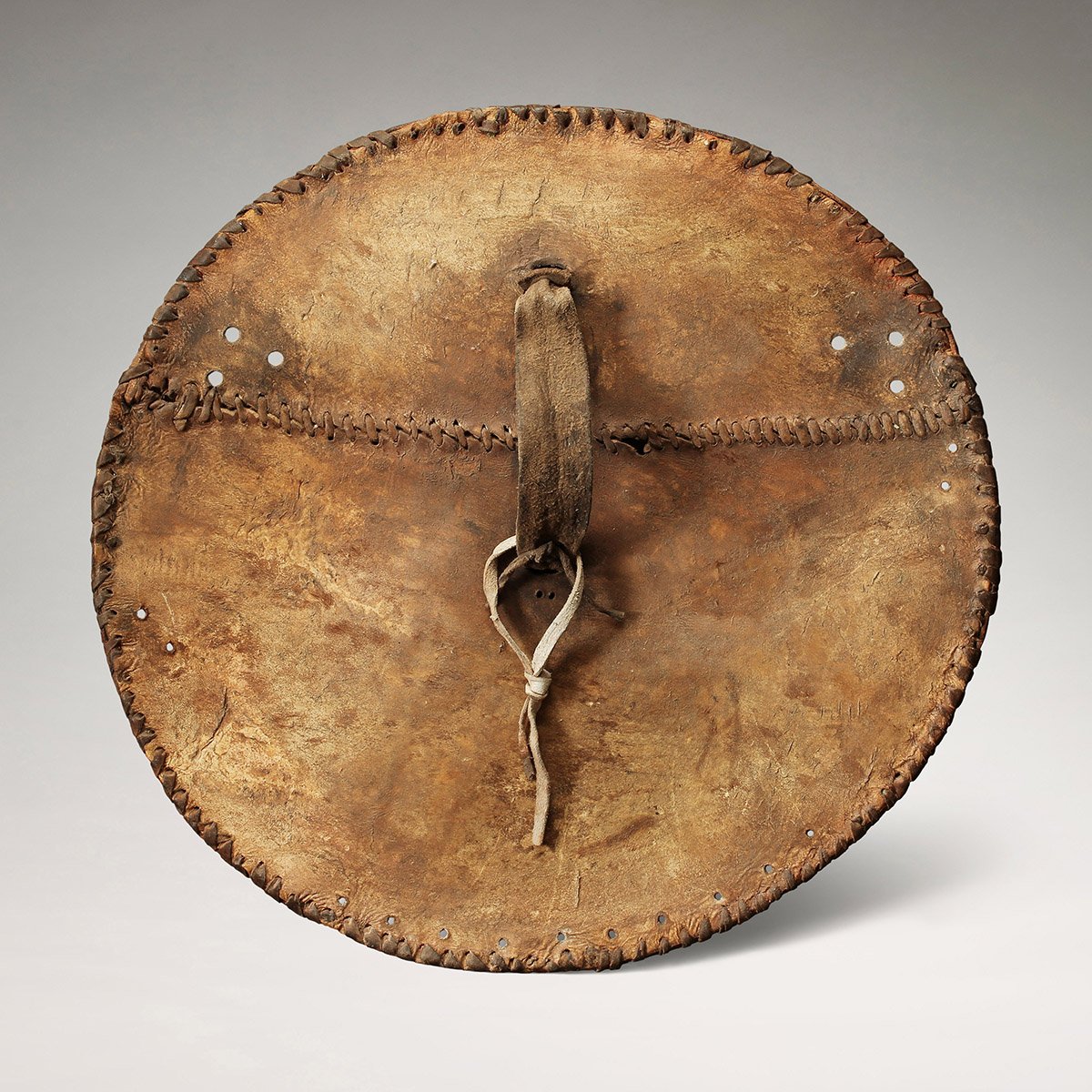 Image 2 of 8
Image 2 of 8

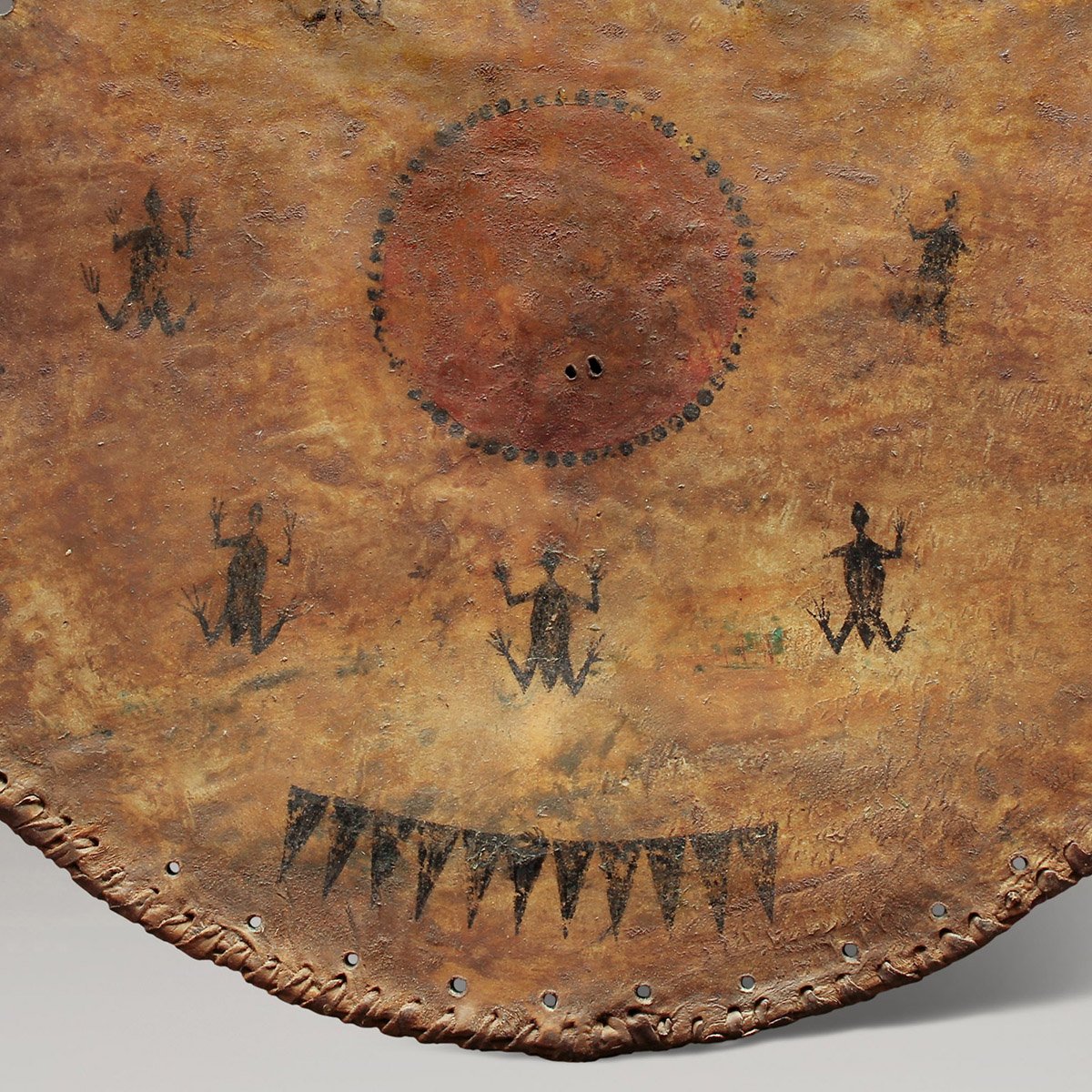 Image 3 of 8
Image 3 of 8

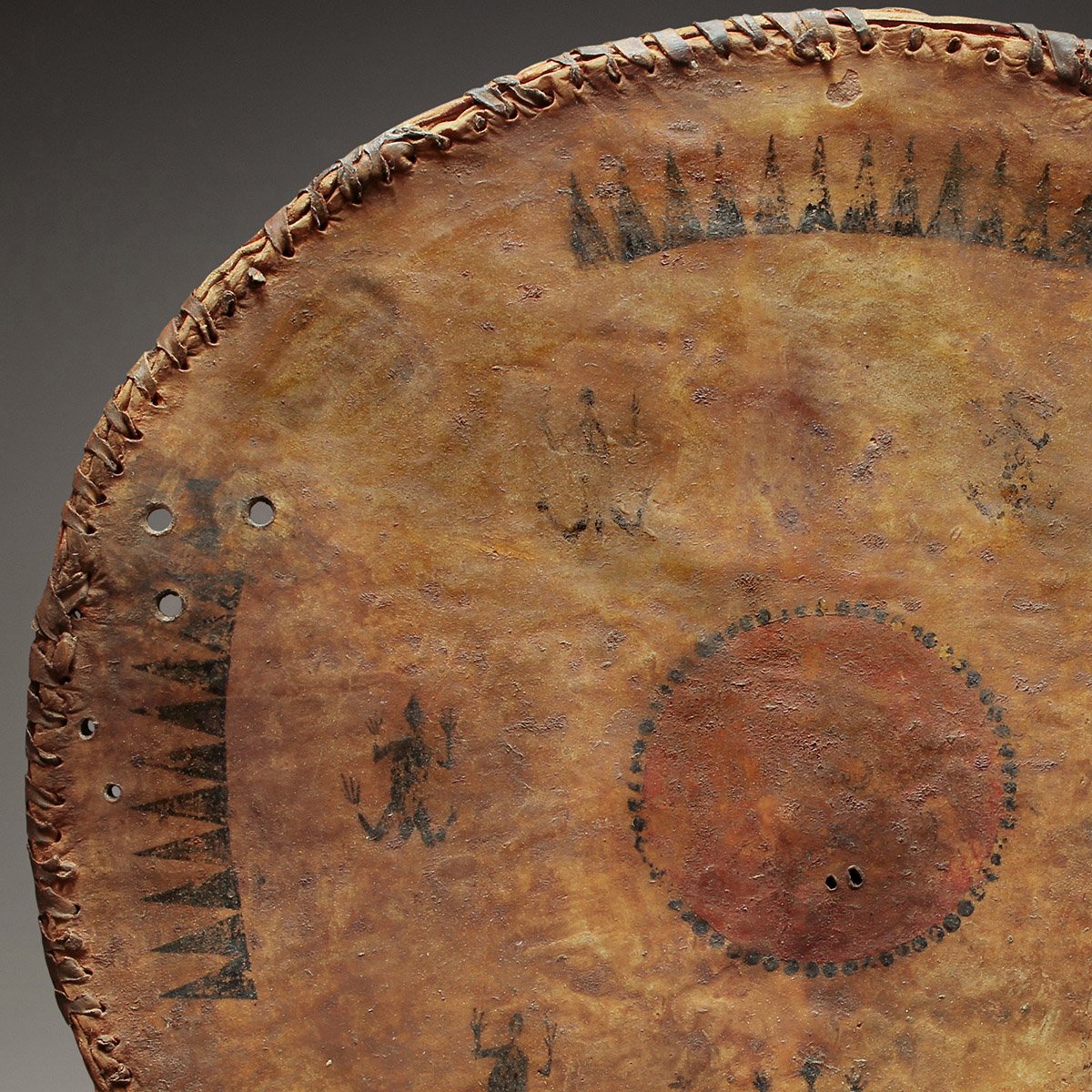 Image 4 of 8
Image 4 of 8

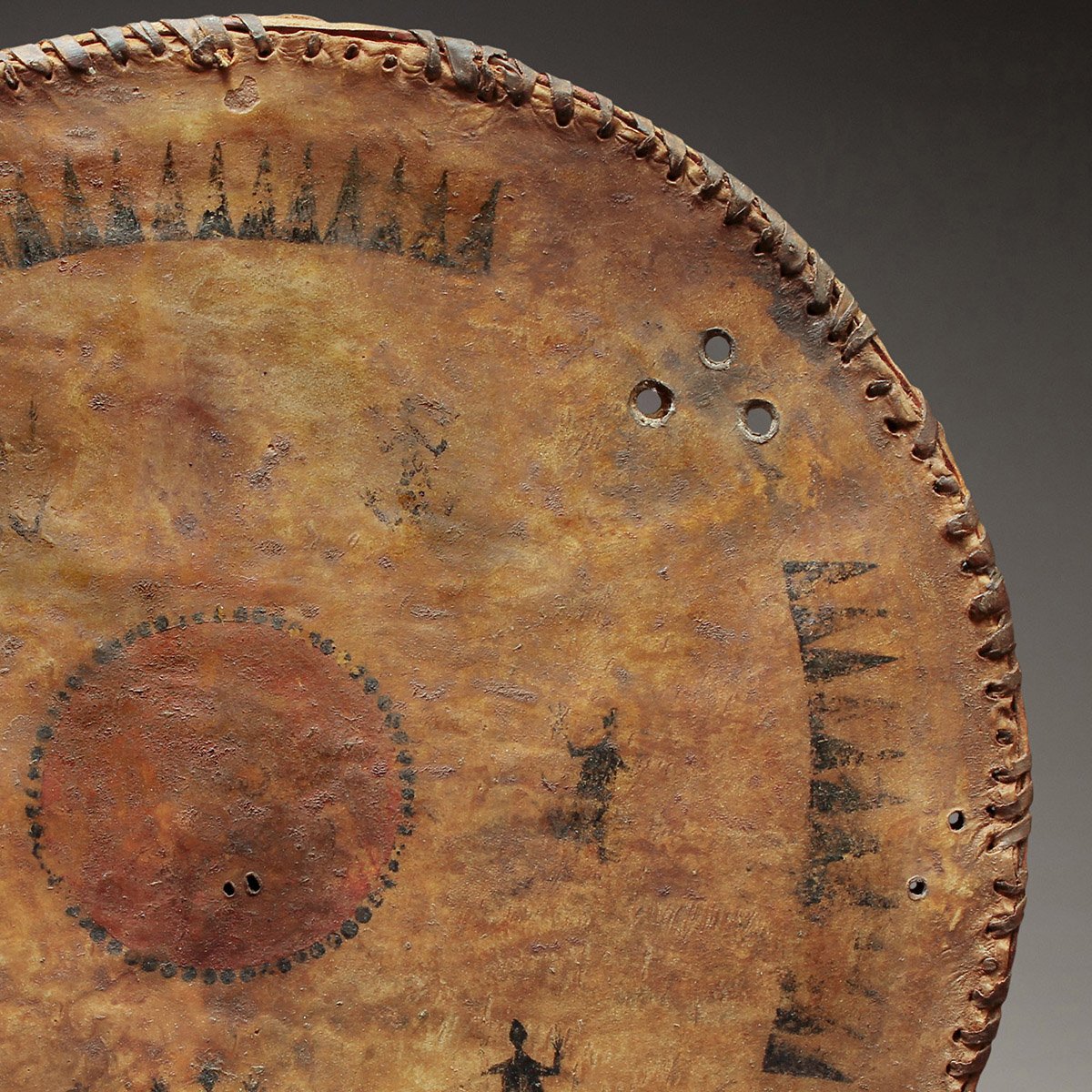 Image 5 of 8
Image 5 of 8

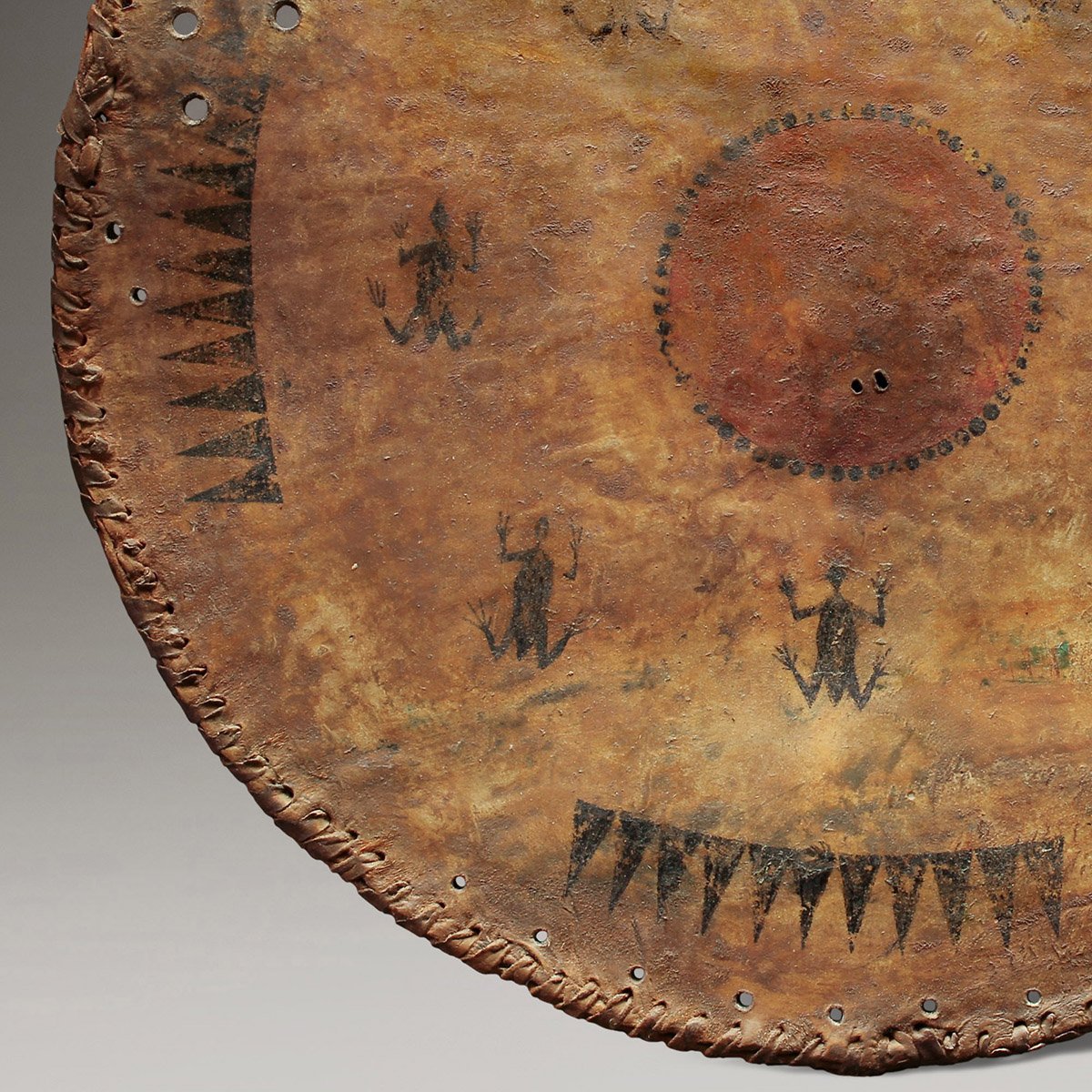 Image 6 of 8
Image 6 of 8

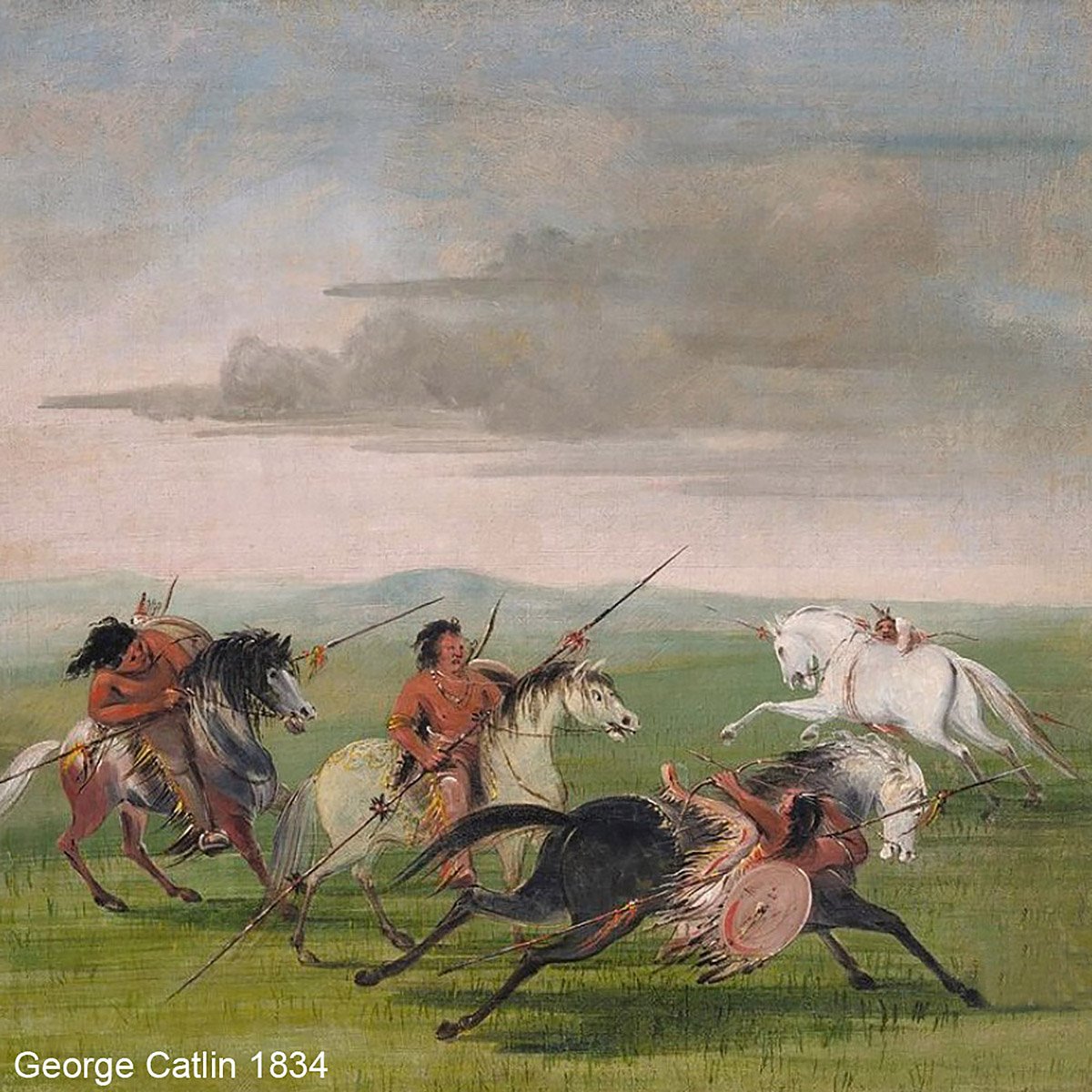 Image 7 of 8
Image 7 of 8

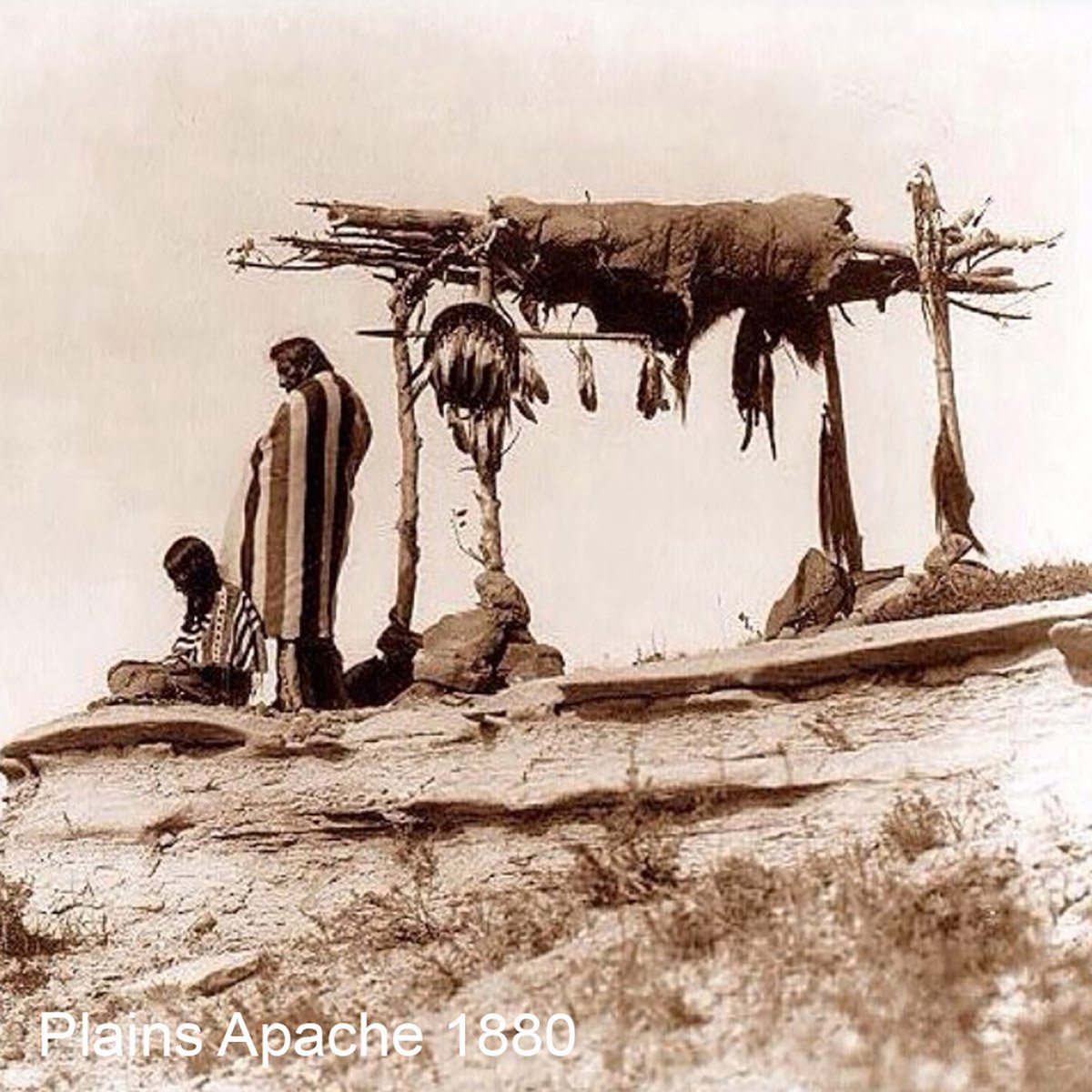 Image 8 of 8
Image 8 of 8









Superb Plains Apache War Shield
Southern Plains, United States
Buffalo hide, mineral pigments.
Diameter: 16.5 inches (42 cm)
Circa 1850/60
Provenance: Private collection – Albuquerque, New Mexico
For several centuries prior to the Reservation period, members of the Tanoan speaking Kiowa tribe and peripheral groups of Athabascan speaking Apache tribes traveled, conducted ceremonies, enjoyed social functions, and hunted and warred together. Historically referred to as “Kiowa-Apache or Plains Apache”, their material culture, including the arts, understandably shared much in common, together producing masterfully tanned buckskin for handsome garments, creating striking beadwork, and excelling at finely detailed hide painting and shield making.
The buffalo hide shield of the Plains Apache warrior constituted his most sacred possession from the time the shield was made for him upon his first encounter with the enemy, until it was laid beneath his head upon his death. Like personal medicine, the shield was associated with a particular spirit animal or patron from which the warrior derived power and protection throughout his life. The warrior’s shield would first take form within a dream, during which the dreamer was instructed by the spirits how the shield must be painted and decorated, how the owner must paint and adorn himself and his pony, and what taboos and other sacred obligations he must observe in order to obtain the protection of the shield’s spirit; which could take the form of an animal or one of the other personified powers of nature. The cutting, painting, and the decorating of the shield with feathers and other magical pendants were all matters of much ceremony, and upon its completion, the shield was formally consecrated in a sweat-house built for the purpose. Finally, the shield’s owner was instructed on his obligations including certain taboos, prayers, songs, and war cries, and specific methods of caring for the shield when in camp. When the owner-combatant carried the shield into battle, the shield’s imagery was revealed at an auspicious moment, releasing the daunting power embodied in the painted images, and thereby delivering a burst of combative energy to his foe. Although the fire-hardened buffalo hide shields of the Plains Apache warrior were fully capable of deflecting enemy arrows or blows from a club or an axe, it was the power of the shield’s painted designs to which the owner of the shield looked to for protection, for the shields were conceived to be primarily of a magical nature. The shield was carried as a symbol of defiance to enemy warriors, a vaunting emblem of the owner’s bravery, and served to illustrate the sources of his spiritual strength and invulnerability, with the owner’s appeals to his animal spiritual helpers portrayed in the shield’s rich symbolism.
This remarkable Plains Apache shield is decorated with a central celestial medallion rendered with a blood-red ocher pigment, symbolizing courage and the menace of warfare. Within the medallion are two oblong holes that pierce the hide through to the back. The distinctive shapes of these holes are consistent with the piercings of an enemy warrior’s triangular stone arrow tip, a tangible reminder of the agile and fearless Plains Apache warrior, supremely skilled with horse and weaponry. Encircling this central motif is a protective formation of seven finely rendered black lizards. The lizard’s ability to regrow lost appendages and to renew their skin through shedding, symbolized survival and healing and granted them spiritual significance among the Apache. The lizard was also an important character in Apache mythology and shamanism, and traditional stories spoke of the lizard’s inquisitive and stealthy nature, helping guide warriors towards success in battle by revealing their enemy’s hidden weakness. One such mythical story tells of a battle with an enemy giant who seemingly could not be defeated despite multiple arrow shots to its chest. It was the lizard, who covertly entered the giant’s camp to discover that the giant had hidden his beating heart within the sole of his foot. The lizard returned to instruct his warrior companions how to successfully dispatch their foe, taking aim at his foot. Surrounding the seven lizards is an array of black triangular motifs set corner to corner in a series of four arcs that are positioned concentrically to the shield’s perimeter. This triangle motif was prevalent among the Apache and there are several interpretations of the Apache triangle motif among scholars, including arrow tips, a sunburst, and in respect to war shields, a graphic representation of its radiant spiritual energy. The shield exhibits honest wear and a lovely warm coloration, the result of its living history among the Plains Apache of the mid-19th century; a time and place where the brutal beauty and vast skies of the open plains served as a backdrop for intense conflict, tribal identity, and spiritual struggle, giving rise to artforms both singular and sublime, often finding its most potent expression in the magical shields of the plains warrior.
Southern Plains, United States
Buffalo hide, mineral pigments.
Diameter: 16.5 inches (42 cm)
Circa 1850/60
Provenance: Private collection – Albuquerque, New Mexico
For several centuries prior to the Reservation period, members of the Tanoan speaking Kiowa tribe and peripheral groups of Athabascan speaking Apache tribes traveled, conducted ceremonies, enjoyed social functions, and hunted and warred together. Historically referred to as “Kiowa-Apache or Plains Apache”, their material culture, including the arts, understandably shared much in common, together producing masterfully tanned buckskin for handsome garments, creating striking beadwork, and excelling at finely detailed hide painting and shield making.
The buffalo hide shield of the Plains Apache warrior constituted his most sacred possession from the time the shield was made for him upon his first encounter with the enemy, until it was laid beneath his head upon his death. Like personal medicine, the shield was associated with a particular spirit animal or patron from which the warrior derived power and protection throughout his life. The warrior’s shield would first take form within a dream, during which the dreamer was instructed by the spirits how the shield must be painted and decorated, how the owner must paint and adorn himself and his pony, and what taboos and other sacred obligations he must observe in order to obtain the protection of the shield’s spirit; which could take the form of an animal or one of the other personified powers of nature. The cutting, painting, and the decorating of the shield with feathers and other magical pendants were all matters of much ceremony, and upon its completion, the shield was formally consecrated in a sweat-house built for the purpose. Finally, the shield’s owner was instructed on his obligations including certain taboos, prayers, songs, and war cries, and specific methods of caring for the shield when in camp. When the owner-combatant carried the shield into battle, the shield’s imagery was revealed at an auspicious moment, releasing the daunting power embodied in the painted images, and thereby delivering a burst of combative energy to his foe. Although the fire-hardened buffalo hide shields of the Plains Apache warrior were fully capable of deflecting enemy arrows or blows from a club or an axe, it was the power of the shield’s painted designs to which the owner of the shield looked to for protection, for the shields were conceived to be primarily of a magical nature. The shield was carried as a symbol of defiance to enemy warriors, a vaunting emblem of the owner’s bravery, and served to illustrate the sources of his spiritual strength and invulnerability, with the owner’s appeals to his animal spiritual helpers portrayed in the shield’s rich symbolism.
This remarkable Plains Apache shield is decorated with a central celestial medallion rendered with a blood-red ocher pigment, symbolizing courage and the menace of warfare. Within the medallion are two oblong holes that pierce the hide through to the back. The distinctive shapes of these holes are consistent with the piercings of an enemy warrior’s triangular stone arrow tip, a tangible reminder of the agile and fearless Plains Apache warrior, supremely skilled with horse and weaponry. Encircling this central motif is a protective formation of seven finely rendered black lizards. The lizard’s ability to regrow lost appendages and to renew their skin through shedding, symbolized survival and healing and granted them spiritual significance among the Apache. The lizard was also an important character in Apache mythology and shamanism, and traditional stories spoke of the lizard’s inquisitive and stealthy nature, helping guide warriors towards success in battle by revealing their enemy’s hidden weakness. One such mythical story tells of a battle with an enemy giant who seemingly could not be defeated despite multiple arrow shots to its chest. It was the lizard, who covertly entered the giant’s camp to discover that the giant had hidden his beating heart within the sole of his foot. The lizard returned to instruct his warrior companions how to successfully dispatch their foe, taking aim at his foot. Surrounding the seven lizards is an array of black triangular motifs set corner to corner in a series of four arcs that are positioned concentrically to the shield’s perimeter. This triangle motif was prevalent among the Apache and there are several interpretations of the Apache triangle motif among scholars, including arrow tips, a sunburst, and in respect to war shields, a graphic representation of its radiant spiritual energy. The shield exhibits honest wear and a lovely warm coloration, the result of its living history among the Plains Apache of the mid-19th century; a time and place where the brutal beauty and vast skies of the open plains served as a backdrop for intense conflict, tribal identity, and spiritual struggle, giving rise to artforms both singular and sublime, often finding its most potent expression in the magical shields of the plains warrior.
Southern Plains, United States
Buffalo hide, mineral pigments.
Diameter: 16.5 inches (42 cm)
Circa 1850/60
Provenance: Private collection – Albuquerque, New Mexico
For several centuries prior to the Reservation period, members of the Tanoan speaking Kiowa tribe and peripheral groups of Athabascan speaking Apache tribes traveled, conducted ceremonies, enjoyed social functions, and hunted and warred together. Historically referred to as “Kiowa-Apache or Plains Apache”, their material culture, including the arts, understandably shared much in common, together producing masterfully tanned buckskin for handsome garments, creating striking beadwork, and excelling at finely detailed hide painting and shield making.
The buffalo hide shield of the Plains Apache warrior constituted his most sacred possession from the time the shield was made for him upon his first encounter with the enemy, until it was laid beneath his head upon his death. Like personal medicine, the shield was associated with a particular spirit animal or patron from which the warrior derived power and protection throughout his life. The warrior’s shield would first take form within a dream, during which the dreamer was instructed by the spirits how the shield must be painted and decorated, how the owner must paint and adorn himself and his pony, and what taboos and other sacred obligations he must observe in order to obtain the protection of the shield’s spirit; which could take the form of an animal or one of the other personified powers of nature. The cutting, painting, and the decorating of the shield with feathers and other magical pendants were all matters of much ceremony, and upon its completion, the shield was formally consecrated in a sweat-house built for the purpose. Finally, the shield’s owner was instructed on his obligations including certain taboos, prayers, songs, and war cries, and specific methods of caring for the shield when in camp. When the owner-combatant carried the shield into battle, the shield’s imagery was revealed at an auspicious moment, releasing the daunting power embodied in the painted images, and thereby delivering a burst of combative energy to his foe. Although the fire-hardened buffalo hide shields of the Plains Apache warrior were fully capable of deflecting enemy arrows or blows from a club or an axe, it was the power of the shield’s painted designs to which the owner of the shield looked to for protection, for the shields were conceived to be primarily of a magical nature. The shield was carried as a symbol of defiance to enemy warriors, a vaunting emblem of the owner’s bravery, and served to illustrate the sources of his spiritual strength and invulnerability, with the owner’s appeals to his animal spiritual helpers portrayed in the shield’s rich symbolism.
This remarkable Plains Apache shield is decorated with a central celestial medallion rendered with a blood-red ocher pigment, symbolizing courage and the menace of warfare. Within the medallion are two oblong holes that pierce the hide through to the back. The distinctive shapes of these holes are consistent with the piercings of an enemy warrior’s triangular stone arrow tip, a tangible reminder of the agile and fearless Plains Apache warrior, supremely skilled with horse and weaponry. Encircling this central motif is a protective formation of seven finely rendered black lizards. The lizard’s ability to regrow lost appendages and to renew their skin through shedding, symbolized survival and healing and granted them spiritual significance among the Apache. The lizard was also an important character in Apache mythology and shamanism, and traditional stories spoke of the lizard’s inquisitive and stealthy nature, helping guide warriors towards success in battle by revealing their enemy’s hidden weakness. One such mythical story tells of a battle with an enemy giant who seemingly could not be defeated despite multiple arrow shots to its chest. It was the lizard, who covertly entered the giant’s camp to discover that the giant had hidden his beating heart within the sole of his foot. The lizard returned to instruct his warrior companions how to successfully dispatch their foe, taking aim at his foot. Surrounding the seven lizards is an array of black triangular motifs set corner to corner in a series of four arcs that are positioned concentrically to the shield’s perimeter. This triangle motif was prevalent among the Apache and there are several interpretations of the Apache triangle motif among scholars, including arrow tips, a sunburst, and in respect to war shields, a graphic representation of its radiant spiritual energy. The shield exhibits honest wear and a lovely warm coloration, the result of its living history among the Plains Apache of the mid-19th century; a time and place where the brutal beauty and vast skies of the open plains served as a backdrop for intense conflict, tribal identity, and spiritual struggle, giving rise to artforms both singular and sublime, often finding its most potent expression in the magical shields of the plains warrior.

